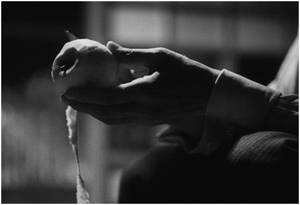August 19th Log
THE BOURNE ULTIMATUM
2007, Paul Greengrass, United States
1st Viewing, Theater
The Bourne trilogy completes with this final installment which is a non-stop adrenaline thrill ride that proves the series has not lost it’s momentum. In Bourne Supremacy talented director Paul Greengrass takes us on an action filled ride that is not dissimilar to the previous film, Bourne Supremacy (also directed by Greengrass). His preference for quick editing and constant hand-held camera photography fits well with the material. Essentially this film is working strongly within genre conventions, yet Greengrass tries to excel beyond conventions in the filmmaking. Successful or not, the film sure is exciting, and (as in the previous Bourne film) features some of the most intense chase sequences of it’s kind. I really don’t think the camera is ever steady or not moving, and the action follows suit as it never lets up. Here we find Jason Bourne, effectively and confidently played by Matt Damon, in a continuous search to discover who he is and as he gets closer more is revealed and the more trouble he finds himself into. In the end he finds himself back at the beginning and it seems a fitting conclusion to the series. I think all three Bourne films are successful in their own way and if there is a difference between them it probably lies in the adrenaline filled action, which seems to increase with each film.
MARIE ANTOINETTE
2006, Sofia Coppola, Japan / France / United States
Repeat Viewing, DVD
Marie Antoinette is very representative of Sofia Coppola’s cinematic style and themes. I love this film in every way. I think because above all, it is one of feeling. Coppola is less interested in ideas (be it political, historical, or psychological). Her interest is in mood, in gestures, tones, themes, and sensibilities. Those looking for intellectual or historic depth may be left disappointed, because this is a film at its best when playful and silly. That is not to say the film is without meaning and importance (or focus). The film distances the viewer from the past and period drama through modern effects (such as the unexpectedly non-distracting new wave music, or the removable of language accents), Coppola ultimately captures an emotional truth. At its core this modernized approach expresses the playful spirit of a young woman’s emotional and physical state. A dreamlike world of being entrapped into an unfamiliar environment of loneliness, and the longing for teenage freedom and possession (as well as rebellion). Often dialogue is never needed here. Through dazzling visuals, set designs, costumes, and makeup Marie Antoinette pitch-perfectly evokes this emotional expression. Based on a sympathetic biography of Maria Antoinette, Coppola is deeply compassionate towards her. Ultimately this is a film of Coppola’s key expression, which is that of a lonely, imprisoned girl who retreats to her own private world of imagination but is destroyed by the uncontrollable desires within (being a young woman). Coppola opens and closes the film with two distinct shots of masterful expression. A truly great filmmaking achievement!



0 Comments:
Post a Comment
Subscribe to Post Comments [Atom]
<< Home